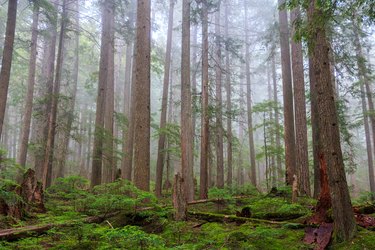
Red cedars aren't "true" cedars, but their common name persists because of similarities to cedars in the Cedrus genus. Although "red cedar" is a term for numerous trees in different genera, arguably the most common red cedars are Eastern redcedar (Juniperus virginiana, USDA zones 2-9) and Western redcedar (Thuja plicata, zones 5-7).
It's understandable that you may wonder just how old that big red cedar is, but the reality is that there's no good way to accurately get the age of your tree without drilling its core and counting the rings. With a tape measure and some math, though, you can get a fair guesstimate to chat about at your next backyard barbecue.
Video of the Day
Video of the Day
Tip
There are several approaches you can take if you want to figure out how old your red cedar is, but they're complicated and imprecise.
Issues With Finding a Tree's Age
They say in real estate that the secret to investment is "location, location, location," and it's true for a tree's success too. Each type has its own growth rate and climate needs, making deducing age a challenging endeavor. Plus, when growing in competition with other trees, they'll grow faster than those standing alone ornamentally. So, it gets complicated.
What's more, climate varies year to year — one year is dry, another may have floods — resulting in everything from ideal tree growth to considerably slowed growth. There is nothing exact about measuring a living tree's age. And even core drilling and dead trees with tree rings can be deceptive, since it's possible for a tree to have two tree rings occurring in one year.
How to Find the Age of an Evergreen Tree: Count Whorls
For young conifers and evergreens, which includes both the Eastern and Western red cedars, you can get an approximate estimate if you can count the whorls of the tree, which are the levels of branches . The whorls are the cross-section of each level of branches. This is clearly a trickier method for large trees, but younger ones should be easy to get a guesstimate on.
Generally, trees will grow a level of branches each year. If you see a level of knots from where a layer of branches was removed, that counts too. If you can see, for example, 12 levels of branches, or 12 rows of whorls, then add 2 years for the tree's sapling period, plus all the whorls — 12, in this case — that gives you an estimate of 14 years.
How to Use the Measuring Method to Find the Age of a Tree
There's a means of using a tape measure to get the radius of a tree, and then there are equations you can do that require the "growth factor" of the tree, which can be a range of factors 5 to 7 for the various cedar types depending on how fast each grows. But all of that is really a lot of fussing for what will still be a best-guess scenario.
As fun as all that math is — guess what? There's an app for that. And though you can download the app, downloading entertaining apps is a security risk that you may want to avoid. Instead, go to Tree-Guide.com. You can select either "cedar" or "cypress, cedar" as many cedars in North America tend to be cypress trees.
You'll still need a tape measure to deduce the measuring starting point (a height of approximately 4.5 feet) and the radius. For a tree on a hill, measure the uphill side and the downhill side to the height of 4.5 feet. The middle of those two ranges is where you get your radius. For the bark, deduct at least 1/2 inch or more for the thickness of the bark before you figure the radius times pi — or 3.14 — to get the "stem circumference."
How to Guesstimate a Tree's Age
Trees in parks and yards grow slower than trees in forests, and red cedars will grow in some areas faster than in other areas due to factors such as climate and soil. Eastern red cedars can grow 30 to 60 feet tall, whereas Western red cedars can grow 50 to 70 feet tall. Once trees reach their peak height, they tend to grow "out," not up, which is why stem measurements are good.
Either way, you're looking at an average growth of 12 to 24 inches per year. Simply knowing the height of the tree and the number of whorls can provide a starting point for determining the age of smaller trees, but for giant red cedars, the trunk radius or stem circumference measurements will yield a better ballpark age.